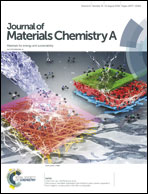Photocatalytic activity and the radiative lifetimes of excitons via an ab initio approach
Abstract
This work presents the radiative lifetimes of photogenerated electron–hole (e–h) pairs in bulk anatase and rutile TiO2 calculated by solving the Bethe–Salpeter equation (BSE) at the G0W0 [F. Fuchs, J. Furthmüller, F. Bechstedt, M. Shishkin and G. Kresse, Phys. Rev. B: Condens. Matter Mater. Phys., 2007, 76, 115109] level with Perdew–Burke–Ernzerhof (PBE) GGA as the starting point, an approach labeled as PBE–G0W0–BSE, where G0W0 is the non-self-consistent GW approximation. The geometry optimization and the electronic ground state are determined using PBE. G0W0, considered as the “gold standard” for band structure calculations, provides band gap results of anatase and rutile in good agreement with experimental values. By solving BSE that surmounts the single-particle picture of individual quasielectron and quasihole excitation, the approach for calculating radiative lifetime shakes off the dependence on the band structure in DFT calculations and the renormalization factors in GW approximation. For anatase, the calculated intrinsic lifetime of the lowest optically active bright excitons turns out to be several microseconds, while that of rutile is a few picoseconds. Overall, the e–h lifetimes of anatase are several orders of magnitude longer than those of rutile, showing good agreement with the experimentally measured values. Longer lifetimes of excitons in anatase lead to observed better photocatalytic activity of these two common TiO2 phases. Our ab initio calculations of exciton lifetimes provide a new insight into understanding the correlation of the widely applicable packing factor model [X. Lin, J. Wu, X. Lue, Z. Shan, W. Wang and F. Huang, Phys. Chem. Chem. Phys., 2009, 11, 10047–10052] with photocatalytic activity, and also a predictive and convenient tool for designing novel materials with potential applications in photonics and optoelectronics.



 Please wait while we load your content...
Please wait while we load your content...